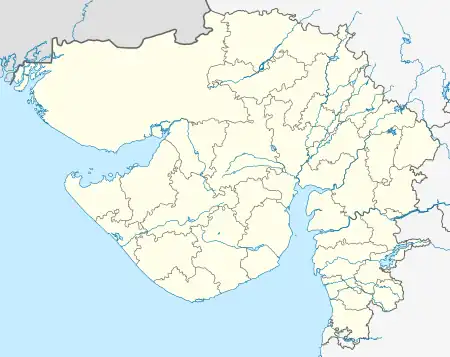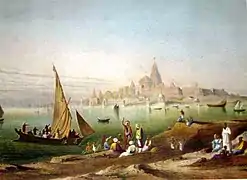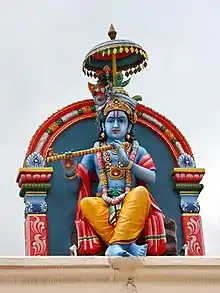Dvārakā
Dvārakā, also known as Dvāravatī (Sanskrit द्वारका "the gated [city]", possibly meaning having many gates, or alternatively having one or several very grand gates), is a sacred historic city in the sacred literature of Hinduism, Jainism,[2][3] and Buddhism.[4][5][6] It is also alternatively spelled as Dvarika. The name Dvaraka is said to have been given to the place by Krishna, a major deity in Hinduism.[7][8] Dvaraka is one of the Sapta Puri (seven sacred cities) of Hinduism.
In the Mahabharata, it was a city located in what is now Dwarka, formerly called Kushasthali, the fort of which had to be repaired by the Yadavas.[9] In this epic, the city is described as a capital of the Anarta Kingdom. According to the Harivamsa the city was located in the region of the Sindhu Kingdom.[10]
In the Hindu epics and the Puranas, Dvaraka is called Dvaravati and is one of seven Tirtha (pilgrimage) sites for spiritual liberation. The other six are Mathura, Ayodhya, Kashi, Kanchipuram, Avantika (Ujjain) and Puri.[11]
Hindu literature
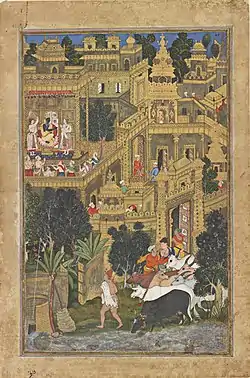
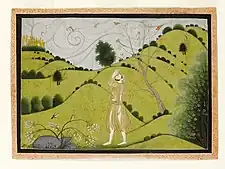
Bhagavata Purana
The following description of Dvaraka during Krishna's presence there appears in the Bhagavata Purana (10.69.1-12) in connection with the sage Narada's visit:
The city was filled with the sounds of birds and bees flying about the parks and pleasure gardens, while its lakes, crowded with blooming indivara, ambhoja, kahlara, kumuda, and utpala lotuses, resounded with the calls of swans and cranes.
Dvaraka boasted 900,000 royal palaces, all constructed with crystal and silver and splendorously decorated with huge emeralds. Inside these palaces, the furnishings were bedecked with gold and jewels.
Traffic moved along a well laid-out system of boulevards, roads, intersections, and marketplaces, and many assembly houses and temples of demigods graced the charming city. The roads, courtyards, commercial streets, and residential patios were all sprinkled with water and shaded from the sun's heat by banners waving from flagpoles.
In the city of Dvaraka was a beautiful private quarter worshiped by the planetary rulers. This district, where the demigod Vishvakarma had shown all his divine skill, was the residential area of Krishna, and thus it was gorgeously decorated by the sixteen thousand palaces of Krishna's queens. Narada entered one of these immense palaces.
Supporting the palace were coral pillars decoratively inlaid with vaidurya gems. Sapphires bedecked the walls, and the floors glowed with perpetual brilliance. In that palace Tvashta had arranged canopies with hanging strands of pearls; there were also seats and beds fashioned of ivory and precious jewels. In attendance were many well-dressed maidservants bearing lockets on their necks, and also armor-clad guards with turbans, fine uniforms, and jeweled earrings.
— Bhagavata Purana, 10.69.1-12
Harivamsa
- In Harivamsa, Dvaraka is described as largely built on "submerged land", "released by the ocean" (2.55.118 and 2.58.34).
- The city was the former "sporting ground of the King Raivataka" called "Dvāravāti", which "was squared like a chess board" (2.56.29).
- Nearby was the mountain range Raivataka (2.56.27), "the living place of the gods" (2.55.111).
- The city was measured by Brahmins; the foundations of the houses were laid and at least some of the houses were built by the Yadavas (2.58.9 - 15).
- It was built by Vishwakarman in one day (2.58.40) "mentally" (2.58.41 and 44).
- It had surrounding walls (2.58.48 and 53) with four main gates (2.58.16).
- Its houses were arranged in lines (2.58.41) and the city had "high buildings" (2.58.50 and 54) (2.58.53), which "almost touched the sky" (2.58.50), and had "doors that had the colour of white clouds" (2.58.48).
- The fort walls of the city were "shining with the colour of the Sun and pots of gold" and "sounds emanating from grand houses sparkling with golden colour" (2.58.53).[12]
- It had a temple area with a palace for Krishna himself, which had a separate bathroom (2.58.43).
- "The city is beautified on Earth by the ocean" like Indra's heavenly city is "beautified by an assembly of important jewels" (2.58.47 - 66, (2.58.49).
Events
- Pandu's sons lived in Dvaraka during their exile to woods. Their servants headed by Indrasena lived there for one year (the 13th year) (4,72).
- Balarama mentioned about a sacrificial fire of Dvaraka, before he set for his pilgrimage over Sarasvati River (9,35).
- Rukmini is described to become the chief queen of Dvaraka after her elopement with Krishna,[13] equated with the goddess Lakshmi as Krishna's chief consort in the Mahabharata.[14]
- One should proceed with subdued senses and regulated diet to Dvaravati, where by bathing in "the holy place called Pindaraka",[15] one obtaineth the fruit of the gift of gold in abundance (3,82).
- King Nriga, in consequence of a single fault of his, had to dwell for a long time at Dvaravati, and Krishna became the cause of his rescue from that miserable plight.(13,72).
- Sage Durvasa resided at Dvaravati for a long time (13,160).
- Arjuna visited Dvaravati during his military campaign after the Kurukshetra War (14,83).
- When the Pandavas retire from the world they visit the place where Dvaraka once used to be and see the city submerged under water.
Related archaeology
During 1983-1990, the Marine Archaeology Unit of India's National Institute of Oceanography (NIO) carried out underwater excavations at Dwarka and Bet Dwarka.[16] According to S. R. Rao "The available archaeological evidence from onshore and offshore excavations confirms the existence of a city-state with a couple of satellite towns in 1500 B.C." He considered it reasonable to conclude that this submerged city is the Dvaraka as described in the Mahabharata.[17]
Submergence
In the Mausala Parva of the Mahabharata, Arjuna witnesses the submergence of Dvaraka and describes it as follows:[18]
The sea, which had been beating against the shores, suddenly broke the boundary that was imposed on it by nature. The sea rushed into the city. It coursed through the streets of the beautiful city. The sea covered up everything in the city. I saw the beautiful buildings becoming submerged one by one. In a matter of a few moments it was all over. The sea had now become as placid as a lake. There was no trace of the city. Dvaraka was just a name; just a memory.
— Mausala Parva of Mahabharata
See also
References
- Manmatha Nath Dutt, Vishnu Purana, Harivamsa (1896), pages 283-286
- Jaini, P. S. (1993), Jaina Puranas: A Puranic Counter Tradition, SUNY Press, ISBN 978-0-7914-1381-4
- Bauer, Jerome H. (24 March 2005). "Hero of Wonders, Hero in Deeds: Vasudeva Krishna in Jaina Cosmohistory". In Beck, Guy L. (ed.). Alternative Krishnas: Regional and Vernacular Variations on a Hindu Deity. SUNY Press. pp. 167–169. ISBN 978-0-7914-6415-1.
- "Andhakavenhu Puttaa". www.vipassana.info. Retrieved 15 June 2008.
- Law, B. C. (1941). India as Described in Early Texts of Buddhism and Jainism. Luzac. pp. 99–101.
- Jaiswal, S. (1974). "Historical Evolution of the Ram Legend". Social Scientist. 21 (3–4): 89–97. doi:10.2307/3517633. JSTOR 3517633.
- Mani, Vettam (2010). Puranic Encyclopaedia (2nd ed.). Delhi: Motilal Banarsidass. p. 89. ISBN 978-8120805972.
- Rajarajan, R.K.K. (2018). "Dvārakā in Tamil Literature and Historical Tradition". Annals of the Bhandarkar Oriental Research, Pune. XCV: 70–90.
- Sharma, Dr. Ishwar Chandra; Bimali, O.N., eds. (2004). Mahabharata: Sanskrit Text and English Translation. Translated by Dutt, M.N. New Delhi: Parimal Publications. ASIN B0042LUAO4.
- 2.56.22–30; Nagar, Shanti Lal, ed. (2012). Harivamsa Purana. Eastern Book Linkers. p. 555. ISBN 978-8178542188.
- Jean Holm; John Bowker (2001). Sacred Place. Bloomsbury Publishing. p. 70. ISBN 978-1-62356-623-4.
- A. Harindranath, ed. (March 2010), "Chapter 2.58: [ITRANS text: dvAravatInagaranirmANam] - Building the City of Dvaravati", Harivamsa in the Mahabharata − Vishnuparva: Sanskrit to ITRANS Sanskrit to English, translated by A. Purushothaman; A. Harindranath, ITRANS text prepared by K.S. Ramachandran, proofreading by Gilles Schaufelberger, Mahabharata Resources. Translators' note; Index to Mahabharata Resources' Harivamsha
- Klostermaier, Klaus K. (1 October 2014). A Concise Encyclopedia of Hinduism. Simon and Schuster. p. 163. ISBN 978-1-78074-672-2.
- Shackle, C.; Snell, Rupert (1992). The Indian Narrative: Perspectives and Patterns. Otto Harrassowitz Verlag. p. 158. ISBN 978-3-447-03241-4.
- Srimad Bhagavatam 11.1.12 (Text Archived 2 December 2008 at the Wayback Machine); Pindaraka entry on Encyclopedia Indica Archived 4 March 2014 at the Wayback Machine
- S. R. Rao 1991, p. 51.
- S. R. Rao 1991, p. 59.
- Diana L. Eck (26 March 2013). India: A Sacred Geography. Three Rivers Press. p. 382. ISBN 978-0-385-53192-4.
Bibliography
- S. R. Rao (1991). "Further excavations of the submerged city of Dwarka". Recent Advances in Marine Archaeology: Proceedings of the second Indian Conference on Marine Archaeology of Indian Ocean Countries, January 1990. pp. 51–59.
{{cite book}}:|journal=ignored (help) - Gaur, A.S., Sundaresh, P. Gudigar, Sila Tripati, K.H. Vora and S.N. Bandodkar (2000) Recent underwater explorations at Dwarka and surroundings of Okha Mandal, Man and Environment, XXV(1): 67-74.
- Gaur, A.S. and Sundaresh (2003) Onshore Excavation at Bet Dwarka Island, in the Gulf of Kachchh, Gujarat, Man and Environment, XXVIII(1): 57-66.
Further reading
- Shikaripur Ranganatha Rao (1999). The lost city of Dvārakā. Aditya Prakashan. ISBN 9788186471487.
